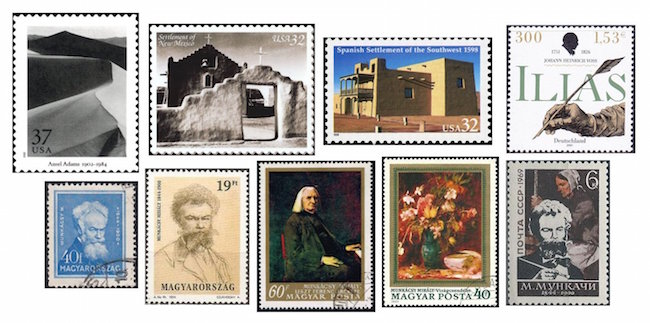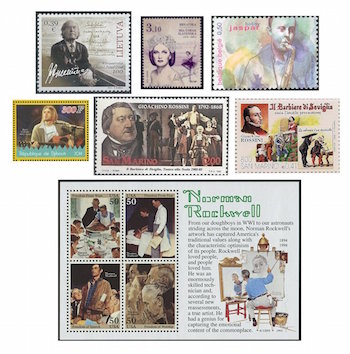The Arts on the Stamps of the World — February 20
An Arts Fuse regular feature: the arts on stamps of the world.

By Doug Briscoe
Our most famous figure today is undoubtedly Ansel Adams (February 20, 1902 – April 22, 1984), and it may be surprising that his only stamp comes from a set honoring American photographers, as opposed to a single stamp for him alone. As a matter of philatelic interest, however, I thought I’d show another Adams design that was proposed to the US Postal Service but not used. It’s one by veteran Dick Sheaff, who has acted as designer or art director for over 500 US stamps. His website shows many of his rejected submissions, one of them a stamp commemorating the settlement of New Mexico using an Ansel Adams photograph. In the end, the USPS decided to go in another direction, and to assuage your burning curiosity I also show the victorious entry (note its somewhat broader subject).
Johann Heinrich Voss (1751 – 29 March 1826) was an important German classicist and poet, who translated Homer’s Odyssey (1781) and Iliad (1793) into German, along with numerous other ancient classics and all the plays of Shakespeare. He also earns a place of note for his own poetry, which was set as Lieder by such composers as CPE Bach, the Mendelssohns (both Felix and Fanny), Brahms, and Weber. A student of philology at the University of Göttingen, Voss went on to teach at various institutions of learning, including the University of Heidelberg. His Shakespeare translations, on which Voss received assistance from his sons, are considered less successful than those of Schlegel. Voss also translated Hesiod, Horace, selections from Ovid, and all of Virgil, among others. Voss, by the way, is credited with the phrase “wine, women and song,” as found in the couplet “Wer nicht liebt Wein, Weib und Gesang / Der bleibt ein Narr sein Lebelang” (“He who loves not wine, woman and song / Remains a fool his whole life long”).
Mihály Munkácsy (MEE-high MOON-kahtsch, more or less; 1844 – 1 May 1900) was born as Michael Leo Lieb in Munkács, Hungary, from which town he later took his pseudonym. He studied in Vienna, Munich, and Düsseldorf before settling in Paris, where he lived the latter half of his life. His earlier work tended to portray peasant scenes, and he earned his reputation with these and his later large-scale biblical paintings before turning to domestic scenes among the rich. One of his most celebrated works is The Last Day of a Condemned Man (1869), which won the Paris Salon’s Gold Medal in 1870. His grand biblical trilogy consisting of Christ in front of Pilate (1882), Golgotha (1884), and Ecce Homo (1896) form another landmark in Munkácsy’s work, as do two huge late pieces, Hungarian Conquest for the Parliament Building in Budapest and Apotheosis (or Glorification) of the Renaissance for the ceiling of the Kunsthistoriches Museum in Vienna (1888). There is also a well-known portrait of Liszt done in 1886, the year of the composer’s death. In view of these concentrations, it may seem odd that the only other Munkácsy picture offered by the Hungarian postal service was a still life, but that stamp comes from a set devoted to flower pictures by various Hungarian artists. We also display a Soviet Munkácsy stamp of 1969. Alas, Munkácsy suffered from a depression that over time became a severe mental illness, probably aggravated by syphilis. Some of his late work, Victim of Flowers, for example, may be seen as reflecting this troubled state of mind. Here is a nice web page devoted to Munkácsy’s work.
Our next two subjects were born on exactly the same day 101 years ago. Lithuanian composer and pedagogue Julius Juzeliūnas (1916 – 15 June 2001) was the foremost representative of “Baltic Minimalism”, combining folkloric intonation with contemporary composition techniques. During World War II he studied organ at the Šiauliai Music School and in Kaunas and Leningrad. Later he taught composition in Vilnius. When he died, twenty of his students collaborated on a memorial composition, “Hommage à Julius Juzeliūnas” for 18 strings. Juzeliūnas’s own works include two operas, an oratorio, and five symphonies.

The remarkable Mia Slavenska (1916 – October 5, 2002) was born Mia Čorak in what today is Croatia. She began dancing at the age of four, studied in Zagreb, made her professional debut at eight, and was prima ballerina of the Zagreb Opera by 17. She danced at the 1936 Olympics in Berlin, winning the choreography and dance award. The following year she left her homeland, changed her name to Slavenska, and appeared in Jean Benoit-Levy’s film Ballerina. She became the leading ballerina with the Ballet Russe de Monte Carlo and fled with them to the U.S. with the coming of World War II. In 1944 she formed the Slavenska Ballette Variante in Hollywood and, in 1947, took American citizenship. A celebrated role for her was as Blanche DuBois in A Streetcar Named Desire, which was first given at Montreal in 1952 with choreography by Valerie Bettis and music by Alex North, who had composed the score for the 1951 film. 1954 saw Slavenska assume the role of prima ballerina with the Metropolitan Opera Ballet. Six years later she opened a ballet studio in New York and after that taught at UCLA and CalArts through the early 1980s.
Belgian jazz musician Bobby Jaspar (1926 – 28 February 1963) learned piano and clarinet in early childhood and took up tenor saxophone and flute later. He moved to Paris in 1950 and in 1956 the U.S., where he played with Miles Davis, John Coltrane, and others. Back in Europe he formed a quintet with his countryman René Thomas, which was occasionally joined by Chet Baker. Bobby Jaspar died young of a heart attack in New York City. He was married to Blossom Dearie.

Another short-lived musician, Kurt Cobain (1967 – April 5, 1994 [body discovered April 8]) was the cofounder of the rock group Nirvana (1987-1994). A broken home led to troubled teen years and depression and no doubt contributed to his subsequent drug abuse, heroin addiction, and, ultimately, suicide. The stamp is excerpted from a Djibouti souvenir sheet of rock musicians dated 2014.
Once more we note the anniversary of an opera première, in this case one of the most famous of them all. Rossini’s Barber of Seville was first heard on this date in 1816 in Rome. (Rossini’s birthday falls on that most elusive of dates, February 29th. This year we’ll pay tribute to him on March 1st.)
Finally for today, a tip of the hat to Norman Rockwell’s iconic Four Freedoms paintings, the first of which, Freedom of Speech, appeared on the cover of The Saturday Evening Post 74 years ago today. The remaining three pictures graced the succeeding covers of the magazine: Freedom of Worship on February 27, Freedom from Want on March 6, and Freedom from Fear on March 13, 1943. The issues contained essays on these topics by Booth Tarkington, Will Durant, Carlos Bulosan, and Stephen Vincent Benét respectively. The Rockwell stamp we saw earlier this month was issued at the same time as this sheet of four in 1994. The original paintings can be see in the Norman Rockwell Museum in Stockbridge, Massachusetts.
Someday, surely, there will be a stamp for Sidney Poitier (born February 20, 1927).
A graduate of the University of Massachusetts with a B.A. in English, Doug Briscoe worked in Boston classical music radio, at WCRB, WGBH, and WBUR, for about 25 years, beginning in 1977. He has the curious distinction of having succeeded Robert J. Lurtsema twice, first as host of WGBH’s weekday morning classical music program in 1993, then as host of the weekend program when Robert J.’s health failed in 2000. Doug also wrote liner notes for several of the late Gunther Schuller’s GM Recordings releases as well as program notes for the Boston Classical Orchestra. For the past few years he’s been posting a Facebook “blog” of classical music on stamps of the world, which has now been expanded to encompass all the arts for The Arts Fuse
